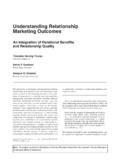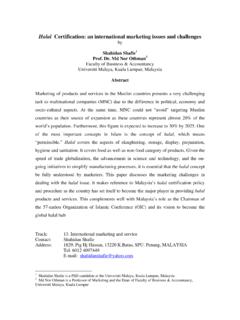Transcription of Technology’s Impact on the Gaps Model of Service …
1 Technology's Impact on the gaps Model of Service Quality Mary Jo Bitner W. P. Carey School of Business Arizona State University Valarie A. Zeithaml Kenan-Flagler School of Business University of North Carolina Dwayne D. Gremler College of Business Administration Bowling Green State University This chapter presents a foundational framework for Service science the gaps Model of Service Quality. For over two decades the Model has been used across industries and worldwide to help companies formulate strategies to deliver quality Service , to integrate customer focus across functions, and to provide a foundation for Service as a competitive strategy. It was developed at a time when most ser- vices were delivered interpersonally and in real time without the advantages (and sometimes disadvantages) of technology infusion.
2 In the intervening years, tech- nology has profoundly changed the nature of Service (s) and at the same time it has influenced strategies for closing each of the Service quality gaps . Thus, this chap- ter has a dual purpose: to provide a general overview of the gaps Model of Ser- vice Quality and to demonstrate how key aspects of the Model have changed and evolved due to advances in technologies. We begin with background on the gaps Model and a discussion of the role of technology and services in general. We then discuss strategies for closing each gap in the Model and illustrate the influence of technologies on these fundamental management strategies. Maglio et al. (eds.), Handbook of Service Science, Service Science: Research and Innovations in the Service Economy, DOI , Springer Science+Business Media, LLC 2010.
3 198 Bitner et al. Introduction Few would argue with the fact that services dominate the economies of the world's most advanced nations. In the , services represent over eighty percent of our GDP and labor force. Further, it is apparent that services are increasing as an economic force in countries such as China, India, and other fast-growing and developing nations (Bitner and Brown, 2008). The growth of Service (s) is a relent- less, global phenomenon that is shaping the world's economies and profoundly af- fecting people's lives. Yet, despite the economic domination of services , there is relatively little formal focus within companies, governments, and universities on Service excellence, Service research, and Service innovation compared to the focus on tangible goods and technologies (see IfM and IBM, 2007).
4 Within this context of unabated growth of Service economies, academics and business practitioners have pointed to the need for tools, techniques, frameworks, and metrics to support excellence and innovation in services across industries. While some already exist, many more are still to be developed. These tools and frameworks will be integral foundations for Service science. This chapter presents and expands one such framework the gaps Model of Service Quality - that has provided a strategic foundation for organizations that wish to deliver Service excellence to their customers. The gaps Model was first introduced in 1985 (Parasuraman et al., 1985; Zeithaml et al., 1990). For nearly twenty-five years it has been used across industries and worldwide to help compa- nies formulate strategies to deliver quality Service , to integrate customer focus across firm functions, and to provide a strong foundation for Service excellence as a competitive strategy.
5 We believe that the gaps Model of Service Quality can be a strong foundation for Service science going forward. Thus, this chapter has a dual purpose: to pro- vide a general overview of the gaps Model of Service Quality and to demonstrate how key aspects of the Model have changed and evolved due to advances in tech- nologies. We begin with background on the gaps Model and a discussion of the role of technology and services in general. We then discuss strategies for closing each gap in the Model and illustrate the influence of technologies on these funda- mental strategies. gaps Model of Service Quality The gaps Model provides an integrated framework for managing Service qual- ity and customer-driven Service innovation.
6 In the years since the Model 's intro- duction, Service quality, Service innovation, and customer focus have all become increasing important as competitive strategies for organizations thus founda- tional, integrative frameworks have more relevance across more industries than ever. A hallmark of the Model is that it captures the cross-functionality inherent in Technology's Impact on the gaps Model of Service Quality 199. Service management. Although the authors are marketing academics and the original publications appeared in marketing journals, their work has been widely cited and used across academic disciplines and implemented in different functions within organizations. The Model draws heavily from logic, theories and strategies in operations, human resources, marketing, and increasingly from information sys- tems.
7 Another hallmark of the Model is its anchoring on the customer and integration of the customer throughout all gaps within the Model . Every gap and every strat- egy used to close the gaps in the Model retains a focus on the customer at its core. The primary goal of the Model is to meet or exceed customer expectations, and strategies used to achieve that objective (whether operations, human resource, or technology-based) are ultimately anchored on the customer. So what exactly is the gaps Model of Service Quality? Figure 1 illustrates the full Model based on the original as it appeared in the Journal of Marketing (Parasuraman et al., 1985) and Figure 2 describes the gaps in words.
8 The center- piece of the Model is the Customer Gap the gap between customer expectations and perceptions of the Service as it is actually delivered. The ultimate goal is to close this gap by meeting or exceeding customer expectations. The other four gaps in the Model are known as the provider gaps and each represents a potential cause behind a firm's failure to meet customer expectations: not listening to cus- tomers (Gap 1); failing to design services that meet expectations (Gap 2); per- formance and Service delivery failures (Gap 3); and not communicating Service promises accurately (Gap 4). At its most basic level, the logic of the Model sug- gests that the Customer Gap is a function of any one or all of four provider gaps .
9 The early publications enumerate the complex reasons that lie behind each of these basic gaps . Later publications and our text (Zeithaml et al., 2009) have fur- ther elaborated on the gaps by delineating specific strategies for closing each of them. In later sections of this chapter we will expand briefly on key strategies used to close each of the gaps . Figure 1. gaps Model of Service Quality 200 Bitner et al. Figure 2. gaps Model of Service Quality in Words In the years since it was introduced, the gaps Model has proved to be adaptable in meeting changes in the global business environment. For example, when the Model was first introduced, few technology or manufacturing companies consid- ered themselves to be Service businesses; therefore, the message of the Model was directed primarily at traditional Service businesses.
10 Today, many progressive companies in the technology and manufacturing sectors also see themselves as Service businesses and the Model is used in these contexts as well. Another major change in the intervening years has been the rapid development of technologies that have affected how services are communicated, designed, and delivered, as well as the types of innovative services now available to customers. An early dis- tinction of services was the fact that they could not be provided remotely; that is, Service was a local function provided in the intimate setting of a provider- customer relationship. Technology has relaxed this fundamental interpersonal, real-time requirement, resulting in increasing accessibility and globalization of services that can now be delivered and consumed anytime, anywhere.



